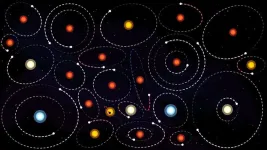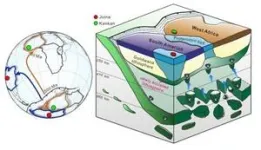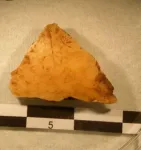(Press-News.org) A new study leverages the NASA Exoplanet Archive and planetary system simulations to make narrowband SETI searches more efficient.
October 23, 2023, Mountain View, CA -- In a new study published in the Astronomical Journal, researchers used the known population of exoplanets and extrapolated to the much larger, unknown population of exoplanets to set better thresholds for planetary effects on signals from ETIs (extraterrestrial intelligences). The prior recommendation for the threshold “drift rate” contribution, caused by a planet’s motion around its host star, was 200 nHz. In this work, lead author Megan Grace Li and her team found that 53 nHz was sufficient in 99% of known-exoplanet cases and that this value drops to a mere 0.44 nHz for stars without known planets. These significant, data-driven reductions in the recommended drift rate threshold will lead to considerable savings in computing time and, therefore, boosted efficiency for future SETI (Search for Extraterrestrial Intelligence) campaigns.
Megan Grace Li, a PhD student at UCLA in UCLA SETI, conducted this research as a National Science Foundation Research Experience for Undergraduates intern in the Breakthrough Listen project at the Berkeley SETI Research Center. “This work gives deeper insight into what extraterrestrially transmitted signals may look like if they come from exoplanets, informing not only the parameter space of technosignature searches but also possible interpretations of detected signals,” said Li.
Due to the Doppler effect, a radio signal sent from a distant exoplanet to Earth may appear at a higher or lower frequency when seen by an observer on Earth. That frequency shift will also change over time due to relative motion between the exoplanet and Earth. This effect of shifting frequency is called a “drift rate.” A similar effect can be observed on Earth when an ambulance zooms by — the siren’s pitch sounds higher as it approaches and then changes to sounding lower as it recedes.
When searching for potential radio signals from exoplanets in a SETI search, it’s essential to consider various factors influencing this drift rate. These factors include the exoplanet’s orbit and rotation and the Earth’s orbit and rotation.
The first part of Li’s paper focused on exoplanets from the NASA Exoplanet Archive (NEA). Li calculated the orbital drift rate distributions for over 5300 known exoplanets, in the process, creating a tool with which researchers can quickly calculate expected drift rates from any exoplanetary system. The researchers found that 99% of the total drift rate distribution fell within 53 nHz.
Dr. Sofia Sheikh, NSF MPS-ASCEND Postdoctoral Fellow at the SETI Institute, mentored and collaborated with Li and co-authored this work. In a previous paper, Sheikh discovered that exoplanetary systems showed drift rates up to 200 nHz in the most extreme cases and recommended this as a threshold. Li’s work builds upon this foundation by considering not only the maximum drift rates from extreme systems but also the average or most likely drift rates from all known systems. “These results imply that, in many cases, the drift rate will be so low that we can prioritize other parameters (such as covering more frequencies or analyzing datasets faster) without worrying that we will miss true signals,” said Sheikh.
The second half of Li’s paper simulated “de-biased” populations of exoplanets that might better represent exoplanetary characteristics in any random sample of the galaxy instead of just the exoplanets that are the most obvious. For example, known planets tend to have “edge-on” orbits because these systems are easiest to detect using the two most common planet-finding techniques, the transit method and the radial velocity method. However, edge-on orbits also have much higher drift rates than planets that are “inclined,” or angled, randomly compared to the observer’s line-of-sight. Li simulated a de-biased population of exoplanets, going beyond the common edge-on orbit case in the NEA and correcting for other observational biases (such as a bias in the NEA for exoplanets that are particularly close to their stars). The group found that a drift rate of merely 0.44 nHz for any random star would be sufficient to capture 99% of hypothetical signals from any orbiting exoplanets.
Searching twice as many drift rates — for example, up to 2 nHz instead of 1 nHz — takes twice as many computations for low drift rates. This new research, which drops the recommended limits by a factor of 4 (for stars with known planets) or over 400 (for stars without known planets), will significantly reduce unnecessary calculations and allow future SETI scientists to fine-tune the drift rate parameters in their searches to better match the particular systems they’re observing.
These new, narrower ranges of maximum drift rates represent a significant efficiency gain in the quest to detect potential radio signals from technologically capable extraterrestrial life.
Read full paper here: https://iopscience.iop.org/article/10.3847/1538-3881/acf83d
About the SETI Institute
Founded in 1984, the SETI Institute is a non-profit, multi-disciplinary research and education organization whose mission is to lead humanity’s quest to understand the origins and prevalence of life and intelligence in the universe and share that knowledge with the world. Our research encompasses the physical and biological sciences and leverages data analytics, machine learning, and advanced signal detection technologies. The SETI Institute is a distinguished research partner for industry, academia, and government agencies, including NASA and the National Science Foundation.
END
New exoplanet-informed research sets clearer bounds on the search for radio technosignatures
A new study leverages the NASA Exoplanet Archive and planetary system simulations to make narrowband SETI searches more efficient.
2023-10-23
ELSE PRESS RELEASES FROM THIS DATE:
Navigating the future of skin health: The 14Th International Conference on Skin Ageing & Challenges 2023
2023-10-23
Lisbon, Portugal – 23 October, 2023
The International Society of Microbiota (ISM) is proud to present the 14th International Conference on Skin Ageing & Challenges 2023. This monumental event will unfold at the Altis Grand Hotel in Lisbon, Portugal, and virtually, on November 9-10, 2023.
Skin ageing, a multifaceted issue combining both basic research, mechanistic, clinical aspects and health concerns, is gaining significant attention in the scientific community.
This year’s conference promises to be a beacon of innovation, ...
Gut fungi's lasting impact on severe COVID-19 immune response
2023-10-23
Certain gut-dwelling fungi flourish in severe cases of COVID-19, amplifying the excessive inflammation that drives this disease while also causing long-lasting changes in the immune system, according to a new study led by investigators at Weill Cornell Medicine and NewYork-Presbyterian. This discovery identifies a group of patients who may benefit from specialized, but yet-to-be determined treatments.
Utilizing patient samples and preclinical models, the research team determined that the growth of fungi in the intestinal ...
Who were the first modern humans to settle in Europe?
2023-10-23
Before modern humans settled definitively in Europe, other human populations left Africa for Europe beginning approximately 60,000 years ago, albeit without settling for the long term. This was due to a major climatic crisis 40,000 years ago, combined with a super-eruption originating from the Phlegraean Fields volcanic area near current-day Naples, subsequently precipitating a decline in ancient European populations. To determine who the first modern humans to settle definitively in Europe were, a team led by CNRS scientists1 analysed the genome of two skull ...
Alem & Narayanan advancing infectious disease capabilities through Biomedical Research Laboratory core support
2023-10-23
Alem & Narayanan Advancing Infectious Disease Capabilities Through Biomedical Research Laboratory Core Support
Farhang Alem, Interim Director of the Biomedical Research Laboratory, Institute for Biohealth Innovation, and Aarthi Narayanan, Professor, Biology, received funding for the project: "Advancing Infectious Disease Capabilities through BRL Core Support."
As part of this project, Alem and Narayanan will: 1) implement a comprehensive BSL-3 facilities preventative maintenance and upgrade plan to ensure continuity of operations, compliance with federal regulations, and a safe and secure facility; 2) enhance safety ...
Ramseur to receive funding for APA fellowship - APA Minority Fellowship Program (MFP)
2023-10-23
Ramseur To Receive Funding For APA Fellowship - APA Minority Fellowship Program (MFP)
Kevin Ramseur, II, a Mason doctoral student studying clinical psychology, is set to receive funding for: "APA Fellowship – APA Minority Fellowship Program (MFP)."
Ramseur will receive $27,144 from the American Psychological Association on a subaward from the Substance Abuse and Mental Health Services Administration (SAMHSA). This funding will begin in Oct. 2023 and will end in late Sept. 2024.
###
About George Mason University
George Mason ...
Doebel innovating developmental science with an online, scalable meta-science platform for investigating cognitive development during early childhood
2023-10-23
Doebel Innovating Developmental Science With An Online, Scalable Meta-Science Platform For Investigating Cognitive Development During Early Childhood
Sabine Doebel, Assistant Professor, Psychology, received $2,784 from the University of Texas at Dallas on a subaward from the National Science Foundation for: "Subaward Project GARDEN: Innovating Developmental Science with an Online, Scalable Meta-Science Platform for Investigating Cognitive Development During Early Childhood."
Regarding the importance of the project, Doebel said, "Project GARDEN will leverage online methodologies to gather data from a large, ...
Debus-Sherrill receives supplemental funds for elevate academy for juvenile providers
2023-10-23
Debus-Sherrill Receives Supplemental Funds For Elevate Academy For Juvenile Providers
Sara Debus-Sherrill, Senior Research Associate, Center for Advancing Correctional Excellence (ACE!), received $153,424 from County of Alameda for: "Supplemental Funds for Elevate Academy for Juvenile Providers." This funding began in Aug. 2023 and will end in late June 2024.
Debus-Sherrill said, "This project funds the development and delivery of a training academy for community-based organizations providing services to justice-involved youth in Alameda County, California."
###
About George Mason University
George ...
Parsa studying design of joint 3D solid-state learning machines for various cognitive use-cases
2023-10-23
Parsa Studying Design Of Joint 3D Solid-State Learning Machines For Various Cognitive Use-Cases
Maryam Parsa, Assistant Professor, Electrical and Computer Engineering, received funding from the National Science Foundation for the project: "Collaborative Research: NCS-FR: DEJA-VU: Design of Joint 3D Solid-State Learning Machines for Various Cognitive Use-Cases."
In this collaborative project, Parsa joins a team of faculty members from the University of Wisconsin Madison (Dr. Akhilesh Jaiswal), and the University of California Irvine (Dr. Babak Shahbaba and Dr. Norbert ...
New study confirms safety and benefits of maternal COVID-19 vaccination for newborns
2023-10-23
Toronto, ON, October 23, 2023 – Infants of pregnant women who received an mRNA COVID-19 vaccine during pregnancy had lower risks of severe health outcomes, neonatal death, and neonatal intensive care unit (NICU) admission, according to a new study from researchers at ICES and the University of Toronto.
Published in JAMA Pediatrics, the study included more than 140,000 infants in Ontario, and also showed that newborn and six-month readmissions to the NICU did not increase in infants of mothers vaccinated during pregnancy.
"Our results were consistent across the number of doses someone received during pregnancy, the trimester in which they were ...
Newborn and early infant outcomes following maternal COVID-19 vaccination during pregnancy
2023-10-23
About The Study: In this study of 142,000 live births in Ontario, Canada, maternal mRNA COVID-19 vaccination during pregnancy was associated with lower risks of severe neonatal morbidity, neonatal death, and neonatal intensive care unit admission and no increase in neonatal readmission or hospital admission up to age six months, compared with no maternal COVID-19 vaccination before delivery.
Authors: Jeffrey C. Kwong, M.D., M.Sc., of ICES in Toronto, is the corresponding author.
To access the embargoed study: Visit our For The Media website at this link https://media.jamanetwork.com/
(doi:10.1001/jamapediatrics.2023.4499)
Editor’s ...
LAST 30 PRESS RELEASES:
Making lighter work of calculating fluid and heat flow
Normalizing blood sugar can halve heart attack risk
Lowering blood sugar cuts heart attack risk in people with prediabetes
Study links genetic variants to risk of blinding eye disease in premature infants
Non-opioid ‘pain sponge’ therapy halts cartilage degeneration and relieves chronic pain
AI can pick up cultural values by mimicking how kids learn
China’s ecological redlines offer fast track to 30 x 30 global conservation goal
Invisible indoor threats: emerging household contaminants and their growing risks to human health
Adding antibody treatment to chemo boosts outcomes for children with rare cancer
Germline pathogenic variants among women without a history of breast cancer
Tanning beds triple melanoma risk, potentially causing broad DNA damage
Unique bond identified as key to viral infection speed
Indoor tanning makes youthful skin much older on a genetic level
Mouse model sheds new light on the causes and potential solutions to human GI problems linked to muscular dystrophy
The Journal of Nuclear Medicine ahead-of-print tip sheet: December 12, 2025
Smarter tools for peering into the microscopic world
Applications open for funding to conduct research in the Kinsey Institute archives
Global measure underestimates the severity of food insecurity
Child survivors of critical illness are missing out on timely follow up care
Risk-based vs annual breast cancer screening / the WISDOM randomized clinical trial
University of Toronto launches Electric Vehicle Innovation Ontario to accelerate advanced EV technologies and build Canada’s innovation advantage
Early relapse predicts poor outcomes in aggressive blood cancer
American College of Lifestyle Medicine applauds two CMS models aligned with lifestyle medicine practice and reimbursement
Clinical trial finds cannabis use not a barrier to quitting nicotine vaping
Supplemental nutrition assistance program policies and food insecurity
Switching immune cells to “night mode” could limit damage after a heart attack, study suggests
URI-based Global RIghts Project report spotlights continued troubling trends in worldwide inhumane treatment
Neutrophils are less aggressive at night, explaining why nighttime heart attacks cause less damage than daytime events
Menopausal hormone therapy may not pose breast cancer risk for women with BRCA mutations
Mobile health tool may improve quality of life for adolescent and young adult breast cancer survivors
[Press-News.org] New exoplanet-informed research sets clearer bounds on the search for radio technosignaturesA new study leverages the NASA Exoplanet Archive and planetary system simulations to make narrowband SETI searches more efficient.




